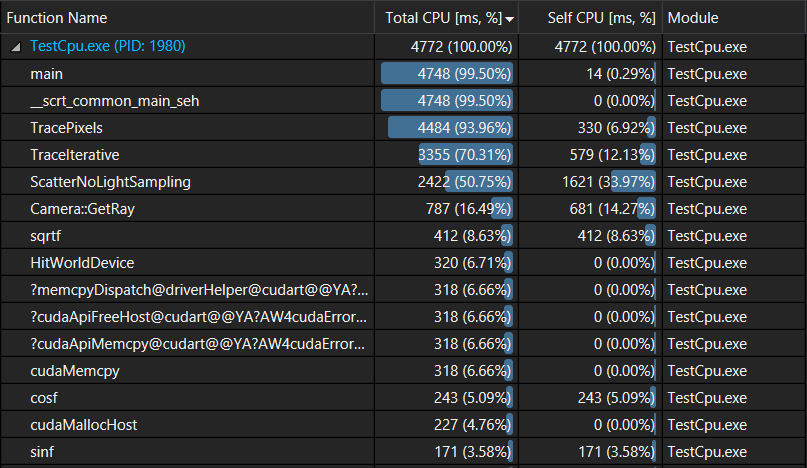Compact Non Active Rays
Alternative handling of done rays
In previous posts we made the decision to copy all rays to the device even if they are done, But if a large proportion of rays is done, then we are wasting time copying them to the device.
I instrumented the code to count how many rays are still active after each depth iteration, and here are the results for one of the rendered frame:
depth 0: 3686400/3686400 (100%)
depth 1: 3133257/3686400 (85%)
depth 2: 910847/3686400 (25%)
depth 3: 466469/3686400 (13%)
depth 4: 154520/3686400 (5%)
depth 5: 87086/3686400 (2%)
depth 6: 42822/3686400 (1%)
depth 7: 28084/3686400 (.8%)
depth 8: 16548/3686400 (.5%)
depth 9: 11901/3686400 (.3%)
depth 10: 7681/3686400 (.2%)
If we count the total number of active rays across all depth iterations we only have ~8.5M active rays from a total of 36.8M rays. So basically only 23% of the data copied actually matters. Memory transfer is expensive so we should only copy the active rays.
Only copy active rays
An alternative to copying all rays to gpu is to remove, or skip, those rays and only handle active rays. An easy way to do this in TraceIterative() is to keep track of a read and write index that both start at 0 and only increment the write index when we process an active ray. We use the write index to write the next active ray. Here is a link to the complete change.
With this change, the renderer’s performance went up to 15.8M rays/s. Nvprof output is as follows:
Type Time(%) Time Calls Avg Min Max Name
GPU activities: 46.38% 168.54ms 111 1.5184ms 1.3760us 7.9660ms [CUDA memcpy HtoD]
37.61% 136.66ms 110 1.2424ms 190.21us 5.2155ms HitWorldKernel(DeviceData, int, float, float)
16.01% 58.181ms 110 528.92us 4.8000us 3.2030ms [CUDA memcpy DtoH]
API calls: 65.26% 385.09ms 221 1.7425ms 48.866us 8.4991ms cudaMemcpy
23.55% 138.96ms 2 69.482ms 7.2482ms 131.71ms cudaMallocHost
7.09% 41.856ms 1 41.856ms 41.856ms 41.856ms cuDevicePrimaryCtxRelease
2.31% 13.629ms 2 6.8145ms 3.2744ms 10.355ms cudaFreeHost
0.99% 5.8636ms 3 1.9545ms 454.38us 3.8287ms cudaMalloc
0.38% 2.2522ms 110 20.474us 8.0230us 44.125us cudaLaunchKernel
0.20% 1.1520ms 3 384.00us 293.93us 551.02us cudaFree
0.16% 934.29us 50 18.685us 364ns 479.91us cuDeviceGetAttribute
0.05% 290.64us 1 290.64us 290.64us 290.64us cuModuleUnload
0.01% 48.866us 1 48.866us 48.866us 48.866us cuDeviceGetName
0.00% 12.398us 1 12.398us 12.398us 12.398us cuDeviceTotalMem
0.00% 8.7520us 1 8.7520us 8.7520us 8.7520us cuDeviceGetPCIBusId
0.00% 2.5510us 3 850ns 364ns 1.8230us cuDeviceGetCount
0.00% 1.0940us 1 1.0940us 1.0940us 1.0940us cuDeviceGet
As we can see memory transfer went down from 1.3s to 385ms and hitWorld kernel from 235ms to 137ms. This is really good compared to the original numbers we had: 4.6s for memory transfer and 386ms for the kernel.
Let’s profile the cpu side of our code to see where we are spending the rendering time now:
Looks like we are on the right track: HitWorldDevice(), which includes memory transfer to and from the gpu + the kernel run, only takes 6.71% of the total execution time.
It’s important to note that the benefits we saw from our change depend on the scene and camera position. I’ts possible to come up with a particular scene where most of the rays bounce back for all 10 depth iterations and remain active all that time. But even for those “worst” cases, only copying the active rays shouldn’t make the performance worse.
